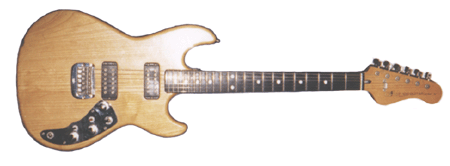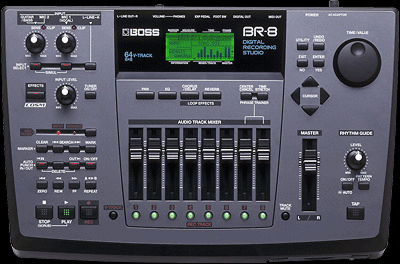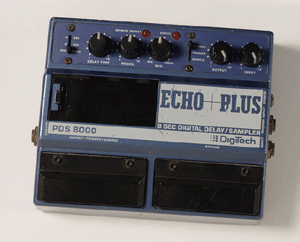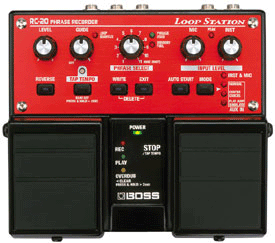
My Equipment List
Just in case you're wondering, here is a list of the instruments and other gear I use to create my music. Also included here are my opinions, reviews if you will, as to what I think of these devices.
G&L F-100 electric guitar: Whatever other instruments I may own, this is one I intend to always hang on to. When my house caught fire on New Year's Eve, 1986, this guitar was one of the few items I was abe to rescue from the flames. It was stolen from me in 1987 and I actually got it back--what are the chances of that? I figure these facts indicate that the Big Black Lesbian in the Sky WANTS me to have this guitar!
Besides my adherence to this divine mandate, I just plain like this instrument. It plays nicely, has a wide variety of sounds, and is comfortable to have hanging on my neck, even through the longest sets. What more could one want from a guitar?
Grade: A+
Click on the picture to visit the G&L website.
Kurzweil K-2000VP synthesizer: I love this instrument! I bought it in 1998 and it has opened up new vistas in my creativity that I previously didn't even have a hint of. The sounds are awesome, the synthesis architecture enables one to create virtually any soundscape imaginable, and it has capabilities that set it far apart from many other keyboard instruments. For me the most important of these is its ability to accept MIDI tuning tables, thus allowing me to explore an infinite variety of microtonal tunings--Asian, African, Middle Eastern, mathematical tunings, and pretty much anything else I can imagine (and probably a few things I have yet to imagine).
There is a wealth of sounds and patches available for this instrument on the Internet and it can play back both WAV and AIFF sample formats. I have collected about 300 discs of sounds and samples for it.
Grade: A+
Click on the picture to visit my Kurzweil links page.
Yamaha APX-4 acoustic/electric guitar: Not a terribly bad guitar, but I probably should have shopped around a bit more. On the plus side, it plays nicely, very much like an electric. It's a pretty decent live instrument.
On the negative side, the sound is a bit tinny, although I can fix this with judicious use of EQ. My biggest gripe with this guitar is the battery that powers the active electronics. It uses a 9-volt battery that fits into a small rectangular housing, which then mounts to a Velcro piece INSIDE the sound hole. To change the battery it is necessary to loosen the E and A strings all the way, then reach inside the sound hole and push the battery housing against the Velcro piece. Even then it doesn't always hold very well. I've had the battery come loose and fall off inside the guitar during performance more than once. What the hell were the folks at Yamaha thinking when they came up with this design? To their credit, more recent models of this guitar house the battery in a trap door on the back of the instrument--much easier to get to.
All my gripes aside, I must say that this guitar has served me well over the years. However, I do not have the sentimental attachment to it that I have to the G&L mentioned above, and if the opportunity (i.e. the financial opportunity) presents itself, I'll replace it in a heartbeat.
Grade: C+

Sequential Circuits Pro-1 analog synth: I got this classic instrument in 1990 at a second-hand store in Springfield, Oregon for a mere $50. I could easily sell it today for $400-$500--if I wanted to. Sequential made this instrument in the early 1980s and it is among the last of the old style analog monophonic synthesizers. Instruments of this type fell out of fashion in the mid '80s (hence the bargain price) but have come back into voque in recent years. This thing does fantastic bass lines, killer leads, and "space" sounds that are truly (dare I say it?) out there. This is a true museum piece. It gets extra "cool" points for its ability to treat external sound sources (guitar, microphone, etc.) through the filter, modulation section, and envelope generators.
Grade: A+

Roland GI-10 Guitar-to-MIDI Converter & GK-2A pickup: WOW!!! This little box and the accompanying pickup have taken my music into a whole new realm. What this device does is allow me to control the synthesizer engine of my Kurzweil with my G&L guitar--a true guitar synthesizer. As of this writing (November, 2002) I've only had this device for about six months and I'm still learning just what it can do. I've composed a few pieces of music with it and am constantly discovering new features. I can have one synthesizer voice across all six strings, or assign a sepearate sound to each string. Because my Kurzweil can be retuned to a variety of intonations (as mentioned above) I am able to play tones that would not be possible with a conventional guitar. Imagine being able to play Balinese gamelan scales on a guitar--awesome!
I have to wonder what Roland was thinking when they stopped manufacturing this thing, settling instead on self-contained guitar synthesizers like the GR-50. With these devices you are locked in to a "dead-end" unit--they're self-contained and only offer limited capabilities--and NO MICROTONAL TUNINGS! Also, they don't work very well for controlling external synths. These units are OK if you want to use the MIDI guitar to play "normal" music, to imitate sounds that have already been used (e.g. playing guitar and making it sound like an accordion). But why would anyone want to do that? Using the GI-10 in tandem with my Kurzweil allows me to explore entirely new musical landscapes--which is the main reason I play music in the first place.
An amusing annecdote: When I first put the GK-2A on my guitar I found that on my high E-string only the first few notes would sond. I figured this was just a limitation of the unit and I accepted that I would just have to live with it. Then I found a picture on the Internet of the unit mounted on a guitar. I noticed that it was mounted in the opposite orientation from mine--turns out I had the darn thing mounted upside down! I flipped it over and it has worked just fine ever since.
Grade: A+
Click on either picture to visit my GI-10 links page.


Line 6 POD guitar processor: A nice little box, kind of like having 16 amplifiers in one container. I must say I'm just a bit disappointed in the effects section, especially the delays. You can't really do much to edit them--no multi-tap, no variable feedback time. In short, it is a straightforward, no frills effects processor. The real strength of this unit is in the amp simulation circuitry. The sounds are incredible and offer the guitarist a wide variety of tones and textures. It's pretty cool being able to go from a classic Fender Tweed to a Marshall Stack with the simple twist of a dial. This device is great on stage and in the studio. I think I'll keep it.
Grade: A-

Boss BR-8-track digital recorder: Again, maybe I should have shopped around. This is not a bad unit--sounds pretty good (24-bit resolution), the effects section (based on the Roland COSM porcessor chip) is pretty cool. The biggest drawback is that it uses 100-megabyte ZIP Discs as a storage medium. 100 megs just isn't very much room when you're working with digital audio. I don't know why Boss (a subsidiary of Roland) couldn't have put a 250-meg ZIP drive into this thing. I can't imagine that it would have added greatly to the cost (the excuse I was given by a customer service rep I spoke with at Roland). Even better would have been a USB port, which would have allowed me to use the hard drive of my iMac as the storage medium.
Still, it's a pretty decent recorder and once I found my way around some of the more cryptic menus I was able to use it pretty effectively. I can connect it via MIDI to my Kurzweil and record audio tracks in sync with the K-2000 sequencer.
Grade: B+

ART Acoustic pedal: A pretty straightforward pedal that does what it's supposed to do. I like it because it gives my Yamaha acoustic/electric a somewhat fuller sound. The effects section is nothing to get too excited about--totally preset, you can't edit anything. This, however, is not a big problem for me, since I generally just want a little beit of chorus or flanger on my acoustic sound. I mostly have only used this pedal for live performance, very little in the studio. One complaint I do have: The graphics have begun to "disappear" and I can no longer read much of the lettering silk screened on the surface of the pedal.
Grade: A

Digitech PDS 8000 Delay/Sampler pedal: I bought this pedal around 1990 and I can't imagine being without it. It is a straightforward digital delay with a full 8 seconds of delay time. I have used it primarily as a looping pedal--I like to create a drone or a phrase, then step on the left footswitch, which makes a loop of what I've just played. Then I improvise over this loop. To put it simply, this pedal has become one of the most important effects processors in my setup. It can also be used as a sampler, although I rarely use it for this.
Grade: A+

Boss RC-20 Loop Station: This is a fairly new acquisition and I haven't had much time to work with it. So far I'm pretty pleased. You plug an instrument into it and play something, then use the footswitches to loop what you've played. You can overdub the loop, press a switch to make it play backwards, and even sync it to a desired rhythm (including odd time signatures). Loop time is a generous maximum of 5.5 minutes (this is total time--overdubbing, etc. reduces the time available). You can even save up to 10 loops when the device is turned off (again, this cuts into the available time) My one complaint is "Guide" feature. This is a metronome for creating loops at a particular rhythm. My gripe with this feature is that it is a bass drum sound that cannot be turned completely off. There is a volume control with which you can turn it all the way down, but I have had several occasions where this control got bumped and turned up, thus allowing the "boom'boom-boom" of the bass drum to sudeenly occur while I was playing. It would have been nice if the manufacturer had added a switch so that this feature could be completely disabled.
Grade: A
